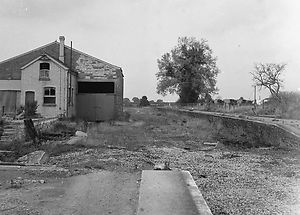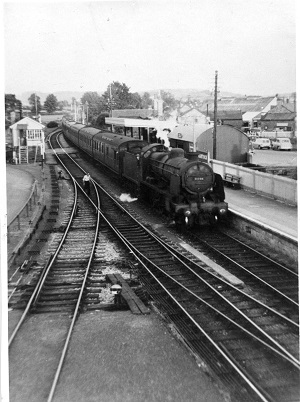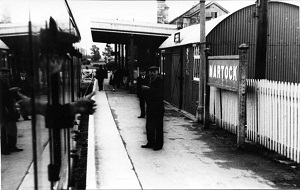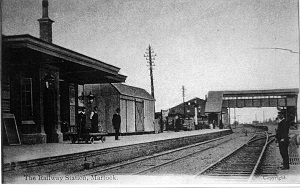The Martock Railway
Martock had a busy railway station between 1853 and 1964 which revolutionized the transport of goods, and made travelling to Yeovil (19 minutes) and Taunton (42 minutes, costing 1 shilling and 9 pence in 1877) easy. In 1913 nearly 33,000 passenger tickets were sold at the station.
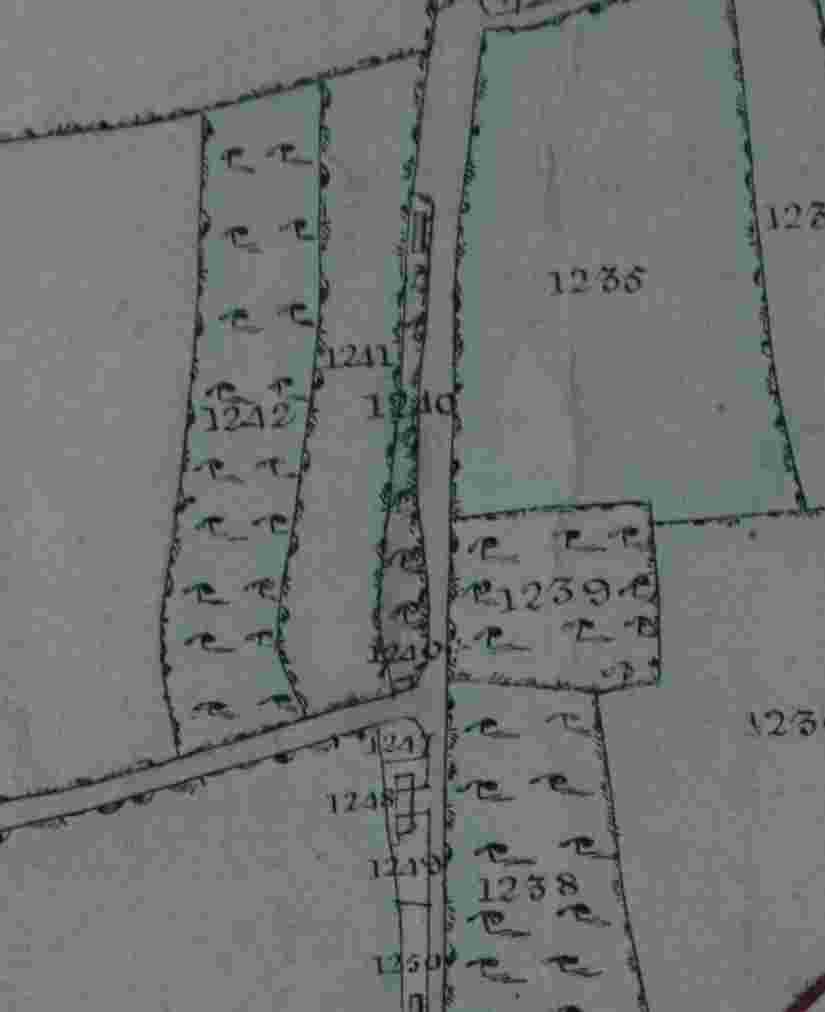 The junction of North street, Stapleton Road and Coat Road in 1823
The junction of North street, Stapleton Road and Coat Road in 1823
Railway mania was in full swing in the mid-19th century, starting in the industrial heartlands of the North. The Bristol to Exeter Railway Company had reached Taunton in 1843 and Exeter in 1844.
At the end of 1844 the Company proposed a branch line from Durston, just east of Taunton, to Yeovil and on to Weymouth. Plans were at all times speculative and a matter of attracting enormous investment. In 1845 a different plan was submitted to build the branch from Bathpool (east of Durston) to Yeovil, passing through Hatch Beauchamp, Isle Abbots and South Petherton. In 1846 an Act was passed for a further branch from Martock to Crewkerne, calling at Stoke, Norton, Chiselborough and Haselbrry. These never materialized, but the race was on to be the first to get to Yeovil
In 1801 Yeovil had a population of 2,774 and Martock 2,102, but Yeovil grew hugely in the 19th century. Its population by 1851 was 7,744, and Martock’s 3,154. The Yeovil branch gained Royal Assent in Parliament in July 1845, giving the Bristol and Exeter Company the right for compulsory acquisition of land en route.
The line to Yeovil opened in October 1853. It was then a single track, but enough land had been purchased to make it double track later. Extra land had also been bought for further sidings to be made at stations such as Martock in the future. It was broad gauge (7’2 ½” wide) until around 1890. Land purchase and earthworks were completed from Martock to Hendford Halt on the edge of Yeovil by 1849. There were money problems and the section across the Levels was not started until 2 years later.
Francis Fox from Abbots Leigh was Engineer to the Bristol to Exeter Railway company. He may have designed the first flat roofed buildings at Martock station. The layout and facilities were relatively large for a branch line station. The goods yard was to the south along Coat Road.
Speculators hoped that the arrival of the railway would bring untold prosperity to any town the railway arrived in. This speculation certainly helped make people invest ib building the line, which was phenomenally expensive, and which never really made as much money as was hoped.
But it did enable quite a bit of new industry to grow in Martock. Goods and supplies could be imported much cheaper. The Bradfords, still trading as builders merchants today, moved to Martock from Throney and establisehed many branches selling coal (their initial business), timber and building supplies. George Parsons could import iron for his magnificent Parrett Works, and later William Sparrow in Bower Hinton. A large cattle market was established by the Palmer family on Fairfield near the station.
The Railway Hotel seems to have been built almost as soon as the railway opened. A solid terrace of railway worker’s cottages were built nearby at Waterlloo Buildings.
1877 fare to Taunton was 4/- first class, 1/9 third class.
1013, 32.865 tickets issued
1932, 15,232 tickets issued
Staff of 15 in 1903, 19 in 1913.
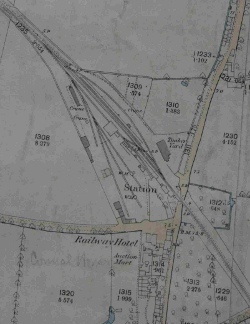 The same view taken from the 1887 Ordnance Survey map
The same view taken from the 1887 Ordnance Survey map
Building of the railway in more detail
GWR railway Paddington to Bristol opened 1841Bristol to Exeter railway company opened railway Temple Meads to Bridgwater opened later the same yearm, Taunton in May 1843, all using broad gueage to fit in with Brunel’s GWR line. All using broad gueage to fit in with Brunel’s GWR line.
In August 1844 the Directors of the B&E railway decided to plan a branch line to Yeovil, Sherborne, Bridport and Weymouth.
Early in 1845 Lady Georgiana Fane of Brympton d’Evercy objected that this line would cut through her estate. The charismatic Brunel assured her that the company would “take such measures as she should suggest to make the line ornamental instead of a deformity”. Thus we have Lady Georgiana to thank for the beautiful Hamstone arched bridges which we today drive under on the A3088 from Martock to Yeovil road, which was built using the dismantled railway line in 1992.
On the 31st July 1845 an Act of Parliament was passed allowing a new railway from the main line at Durston, just east of Taunton, across the marshes of Athelney to Langport, Martock and Yeovil.
In 16th July 1845, amid the enthusiasm of “Railway Mania”, a further act was passed in Parliament for a branch line from Martock to Crewkerne, calling at Stoke, Norton, Merriott and Haselbury Plucknett. Sadly this scheme never got off the ground.
Contracts were agreed on the construction of the Yeovil branch through Martock early in 1847. Messrs Rigby started on the earthworks between Martock and Yeovil. Not surprisingly, there were endless unforeseen snags such as wells running dry in Brympton and Houndstone, and the Yeovil watchmen requested and extra 1 shilling to pay for the trouble caused by so many navies frequenting the town. Work on this phase was completed in less than two years.
After completion of the earthworks it was not until April 1852 that the Board of Directors, together with Brunel and the line’s Engineer Francis Fox, authorised the construction of the line from Martock to Durston, the positioning of the stations, together with an intended connection from Yeovil Town of Pen Mill. The railway from Bristol to Weymouth was at this stage only a pipe dream.
Francis Fox had estimated the cost of this part of the work to be £130, 646 1s. & 1d. Tenders for the work came in between £106,000 and £81,000. The cheapest tender from William Baker was accepted, but he soon found he could not build it for this little, and the tenders were thrown open again. Messrs Huthinson & Ritson were appointed contractors at £86,000.
Work started but floods on the Levels delayed work that winter, and fire destroyed the Contractor’s works in Bridgwater, but the line was ready as far as Hendfod Halt in Yeovil by September 1853.
That month an inspection of the railway was carried out by Lt. Tyler Royal Enginees, representing the Board of Trade, together with senior officials of the Bristol & Exeter company.
The Inspector’s Report tells us that although the line was single track, enough land had been bought to make it a double line later. At this stage there were only sidings at two stations on the 18 miles between Durston and Yeovil. The branch had followed the broad gauge of Brunel with “broad gauge”, the rails being 7ft. 2 ½ ins. wide. Unlike today, 14” x 7” sleepers were laid along the length of the rails, with sleepers connecting the rails only every 15 feet.
He reported that the line as far as Langport crosses the boggy Moors, but that the Conpany planned for much of the freight to be carried by water as far as Langport! 58 aqueducts and large culverts had been built across the Moors, with piles driven 40 to 50 feet deep for support of the railway.
He was concerned that some of the embankments over the Moors were not firm enough. He thought the foundations mostly satisfactory except in one place where faggots had been put under the high peat-built embankment.
He strongly recommended that, in 4 places, speeds should not exceed 20 miles per hour.
There were 23 bridges, some supported on timber bu mostly stone. Only one caused concern, the bridge at Cartgate (now gone) which had a shew span of 79 feet. This had cracked arch spandrels on both sides. The Inspector was assured that this had been like it since constructed 3 years earlier and hadn’t moved since. The Inspector grudgingly allowed this, so long as the cracks were carefully monitored.
The day of opening
The first train ran at 11.30 from Durston on 1st October 1853. All along the line people turned out to celebrate and watch the first official train. We have no record of parties in Martock, but in Yeovil many factories closed to allow thousands of people to gather near the station for the first train.
It was late! The band played “Oh dear! What can the matter be?”, but when the train finally arrived at 2.30 they played “See the conquering hero come!”
There were then 4 passenger train sevices a day, taking 1 hour 10 minutes each way from Taunton to Yeovil. The first goods train ran on 12th October. In November licenses were granted to traders in the goods yards. Coal was being carried for 1s, 4d, per mile, and trade rapidly increased.
The Bristol & Exeter had a monopoly on trade in Yeovil until the Pen Mill line from Brisotl opened in September 1856, from which time profits were evermore uncertain on our Martock line.
Amongst the first were Stuckey and Bagehot of Langport, and Job Bradfrod of Throney. Bradfrods still occupy the site of the goods yard at Hendford Halt today, 160 years later.
